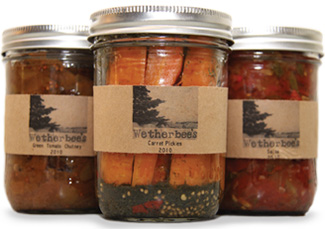
Making the most of Local Produce
 With the multitude of farms in our community, there is abundant, amazing produce available during the season. Sadly, the season in Massachusetts doesn’t last all year, but your produce can. Here are ten tips to help you enjoy that abundance all year ‘round. For more information on where to find organically grown fruits and veggies, check out our sidebar.
With the multitude of farms in our community, there is abundant, amazing produce available during the season. Sadly, the season in Massachusetts doesn’t last all year, but your produce can. Here are ten tips to help you enjoy that abundance all year ‘round. For more information on where to find organically grown fruits and veggies, check out our sidebar.
one Grow Your Own.
The best food is the freshest food, so trying growing some favorites of your own at home. With a small garden or a handful of planters you can have ready access to the best organic produce around. Some area farms sell seedlings in the spring (see sidebar) or check out High Mowing Seeds of Vermont (www.highmowingseeds.com) for high quality, organic seeds.
two Moist and Cool.
The rule of thumb for most fresh produce is: moist and cool. Most vegetables, including farm staples like greens, broccoli, and herbs, should be kept in the refrigerator in breathable bags. For a neat craft project, make washable, reusable fabric produce bags out of old sheets or pillowcases. If you stick with plastic, don’t be afraid to rinse and reuse.
three Know Exceptions.
Basil leaves are sensitive to moisture and cold, so treat them like flowers: trim their stems and keep them on the counter in a glass of water. Wash leaves just before use and pat them dry or they will turn a lovely brown-black. While most melons can be left on the counter to ripen, watermelons don’t continue to ripen once picked, so they should be stored in the fridge.
four Tomato Basics.
Cherry tomatoes are picked ripe, so eat them immediately or keep on your counter for up to a few days. Full-size tomatoes are usually under-ripe when purchased. Leave them on the counter (in a brown bag or not) for a few days until fully ripe. Don’t store unripe tomatoes in the refrigerator or they will never ripen. If you choose to store ripe tomatoes in the fridge, bring them to room temperature before eating.
five Start Putting By Early.
It may seem as though tomatoes are never-ending in August, but by October when you’re ready to put by for the winter, they’ll be in short supply. An afternoon of preparation here and there during the season can also make the idea of filling your whole pantry a lot less foreboding. Dry, freeze, and can when things are most abundant.
six Try Dehydrating.
Dehydrators are relatively inexpensive (Amazon has a good selection ranging from $40 to over $400) and many ovens now have a low-temperature dehydrator setting. Make your own “sun”-dried tomatoes, store extra herbs, and dry berries or homemade fruit leather for great snacks.
seven Can It.
Acidic foods (tomato sauce, salsa, pickles, apple sauce) are easy to make and safe to can at home in a hot water bath. The USDA’s canning guide is a great resource (www.foodsaving.com/canning_guide) or check NOFA’s Web site for a schedule of classes to learn all about it (www.nofamass.org/programs/extensionevents/preservation.php). Local hardware stores should have everything you need from jars to pickling spices to canning kits.
eight Freeze Fresh.
To freeze most veggies, clean, cut, blanch, and bag. Mainstays like green beans, berries, and tomatoes freeze very well, but think outside the usual freezer bag. Try freezing corn, pre-made stir fry mixes, or pie fillings. For instructions or ideas, pick up the classic Putting Food By: Fifth Edition by Janet C. Greene, Ruth Hertzberg, and Beatrice Vaughan (Plume Books, 1988).
nine Overwinter.
Most of us don’t have root cellars to rely on these days, but you can still easily overwinter produce like potatoes, onions, carrots, squash, and apples. Check our Facebook page (www.facebook.com/wellesleywestonmagazine) for a handy chart on the conditions veggies like best and storage instructions. Garages, extra refrigerators, and bulkheads are all great root cellar alternatives, or you can build your own: Build Your Own Underground Root Cellar by Phyllis Hobson (Storey Publishing, 1981) demonstrates a simple design.
ten Plan Ahead.
Many of the farms in our area are Community Supported Agriculture farms (CSAs) only and they fill up early. Check out Web sites, talk to your friends, and sign up over the winter for the following farm season. In mid-February, take stock of what produce you have left from the previous season and make a list of what you wish you had. Next season, you’ll be ready to go. ![]()
Where to Find Local Produce
Other Resources:
© 2011 Elm Bank Media | Beth Furman, Publisher | Beth@ElmBankMedia.com


recent comments